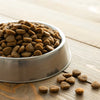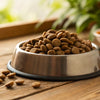Can You Add Milk to Dry Dog Food? Unpacking the Benefits and Risks
- Houndsy
Table of Contents
- Introduction
- The Nutritional Value of Milk
- The Risks of Adding Milk to Your Dog's Diet
- Alternatives to Milk for Enhancing Dry Dog Food
- Practical Tips for Incorporating Liquid into Your Dog's Meals
- Elevate Your Dog's Feeding Experience with Houndsy
- Conclusion
Introduction
Did you know that nearly 44% of pet parents express uncertainty about the best feeding practices for their dogs? It’s a common dilemma that leads us to ask questions such as, "Can I add milk to my dog's dry food?" This inquiry reflects our deep desire to enrich our dogs' meals while ensuring we meet their dietary needs. At Houndsy, we're passionate about enhancing the daily feeding experience for our canine companions, and this topic is certainly worth exploring.
In this blog post, we will delve into the complexities of adding milk to dry dog food, examining its potential benefits and risks, as well as discussing alternatives that can provide nourishment and flavor. By the end of this article, we aim to empower you with the knowledge to make informed decisions about your dog's diet, ensuring they receive optimal nutrition in a safe and enjoyable manner.
We will cover various aspects related to the question of adding milk to dry dog food, including:
- The nutritional value of milk for dogs
- The risks associated with milk consumption
- Alternatives to milk for enhancing dry dog food
- Practical tips for incorporating liquids into your dog’s meals
By addressing these topics, we hope to provide a comprehensive understanding of how to elevate your dog's dining experience while prioritizing their health and well-being.
The Nutritional Value of Milk
Milk has long been celebrated for its rich nutritional profile, which includes:
- Proteins: Essential for muscle development and repair.
- Fats: A source of energy and support for healthy skin and coat.
- Calcium: Important for strong bones and teeth.
- Vitamins: Including vitamin B12 and riboflavin, which play vital roles in cellular function and energy production.
For many dogs, particularly puppies, milk can be a nutritious addition to their diet. However, the ability to digest milk diminishes as dogs mature, leading us to the question of whether milk is suitable for adult dogs.
The Risks of Adding Milk to Your Dog's Diet
While milk can offer nutritional benefits, it’s crucial to recognize that not all dogs can digest it effectively. Many adult dogs experience lactose intolerance, which means they lack the enzyme lactase necessary to break down lactose, the sugar found in milk. This can lead to gastrointestinal upset, including symptoms such as:
- Diarrhea
- Gas
- Vomiting
- Stomach cramps
As responsible pet parents, we must carefully observe our dogs' reactions to dairy products. If you notice any adverse effects after adding milk to their meals, it is best to discontinue this practice.
Key Considerations
- Lactose Intolerance: This condition varies from dog to dog, with some able to tolerate small amounts of dairy while others cannot handle it at all. Signs of lactose intolerance can manifest shortly after consumption, making it vital to monitor your dog closely.
- Weight Gain and Obesity: Milk contains calories that can contribute to weight gain if consumed in excess. Dogs that are already on the heavier side should be monitored closely when introducing new foods into their diet.
- Allergies and Sensitivities: Just like humans, dogs can develop allergies to proteins found in milk. If your dog shows signs of an allergic reaction—such as itching or rash—it’s essential to consult your veterinarian.
Alternatives to Milk for Enhancing Dry Dog Food
If you’re looking for ways to enhance your dog’s dry food without the risks associated with milk, several alternatives can provide flavor and moisture while being easier on their digestive systems:
- Plain, Unsweetened Yogurt: This can be a healthier alternative to milk. The fermentation process reduces lactose content, making it easier for many dogs to digest. Additionally, yogurt contains probiotics that can promote gut health.
- Bone Broth: This nutritious stock is made by simmering animal bones in water for an extended period. Bone broth is loaded with vitamins and minerals, benefits joint health, and can also help with hydration.
- Vegetable or Meat Broth: Low-sodium vegetable or meat broth can add flavor and moisture to your dog's dry food, making it more enticing. Just ensure that the broth does not contain any harmful ingredients like onions or garlic.
- Warm Water: Sometimes, the simplest solution is the best. Adding warm water to your dog’s dry food can enhance its aroma and texture, encouraging them to eat. Let the kibble soak for a few minutes to soften it before serving.
Practical Tips for Incorporating Liquid into Your Dog's Meals
At Houndsy, we understand the importance of creating an enjoyable feeding experience for both you and your dog. Here are some practical tips for incorporating liquids into your dog’s meals effectively:
- Mix Well: Ensure that the liquid is evenly distributed throughout the kibble. This will help your dog enjoy every bite without leaving any dry pieces behind.
- Soak Before Serving: Allow the kibble to soak in the liquid for about 10-15 minutes before serving. This will enhance the flavor and make it easier for your dog to chew, especially for senior dogs or those with dental issues.
- Monitor Their Response: Keep an eye on your dog after introducing liquids to their meals. If you notice any signs of gastrointestinal distress, consult your veterinarian.
Elevate Your Dog's Feeding Experience with Houndsy
At Houndsy, we are dedicated to simplifying and elevating the dog feeding experience. Our flagship product, the Houndsy Kibble Dispenser, is designed for design-conscious pet parents who appreciate both form and function. With its ergonomic design and large storage capacity of 25–30 lbs, it eliminates the need for bending and messy spills, allowing for perfect portion control every time.
Key Features of the Houndsy Kibble Dispenser:
- Convenient Crank at Standing Height: No more bending down to serve your dog's food.
- Perfect Portion Control: Ensure your dog receives the right amount of kibble every time.
- Stylish Mid-Century Modern Design: Complements your home decor while enhancing your dog's feeding area.
- BPA-Free Liner: Keeps food fresh and safe for your furry friend.
- Auto-Locking Mechanism: Prevents accidental dispensing by curious pets or toddlers.
Explore our Accessories Collection to find matching water bowls and other products that will elevate your pet care routine and enhance their feeding experience.
Conclusion
In conclusion, while adding milk to your dog's dry food may seem like a tempting way to enhance their meals, it’s essential to carefully consider the potential risks involved. Many dogs are lactose intolerant, which can lead to digestive issues and other health problems. Instead, consider incorporating alternatives such as bone broth, yogurt, or vegetable broth to add flavor and moisture to your dog’s food.
By prioritizing your dog's health and well-being, you can create a feeding routine that is both enjoyable and nutritious. We invite you to explore the Houndsy Kibble Dispenser and our Accessories Collection to further enhance your dog's feeding experience.
FAQ
- Is it safe to give my dog milk? While some dogs may tolerate small amounts of milk, many are lactose intolerant. Monitor your dog's response and consult your veterinarian if you notice any adverse effects.
- What are some safe alternatives to milk for dogs? Consider using bone broth, plain yogurt, or low-sodium vegetable broth to enhance your dog's dry food.
- Can I add liquid to my dog's kibble? Yes! Adding warm water or broth can make kibble more appealing and easier to chew.
- How can I ensure my dog is getting the right nutrition? Consult your veterinarian to determine the best diet for your dog's specific needs and consider incorporating high-quality dog food along with fresh whole foods.
- How can the Houndsy Kibble Dispenser help with my dog's feeding routine? The Houndsy Kibble Dispenser offers a convenient, stylish, and efficient way to serve your dog kibble while ensuring perfect portion control and maintaining freshness.












